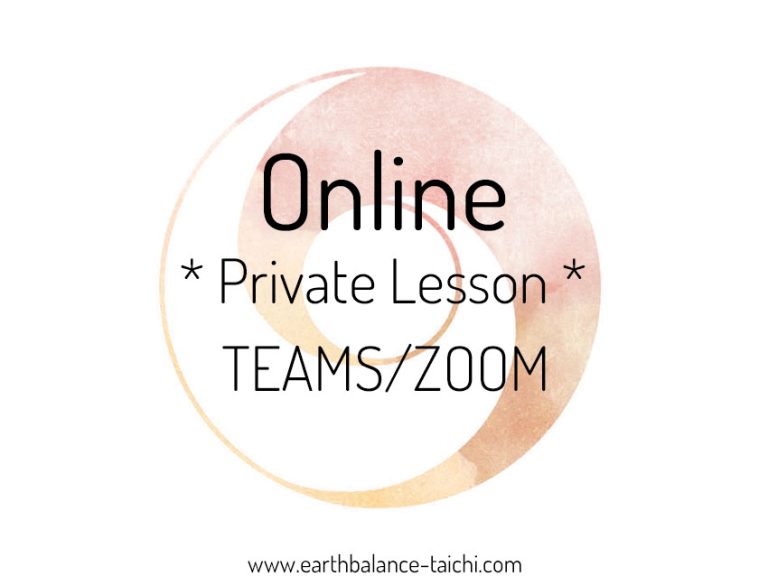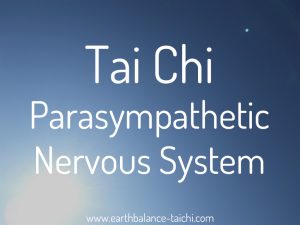Qigong Wall Squatting

Qigong Wall Squatting
The Qigong wall squat is a dynamic whole body movement. An ultimate squat that develops leg strength, power, balance and body awareness. The stretching and relaxing wave like motion in the spine gives circulation a boost, helps the body detox and massages your internal organs to aid their functioning. As a beginner there are modifications that help you build up strength and balance gently over time, before you progress to performing full wall squats daily.
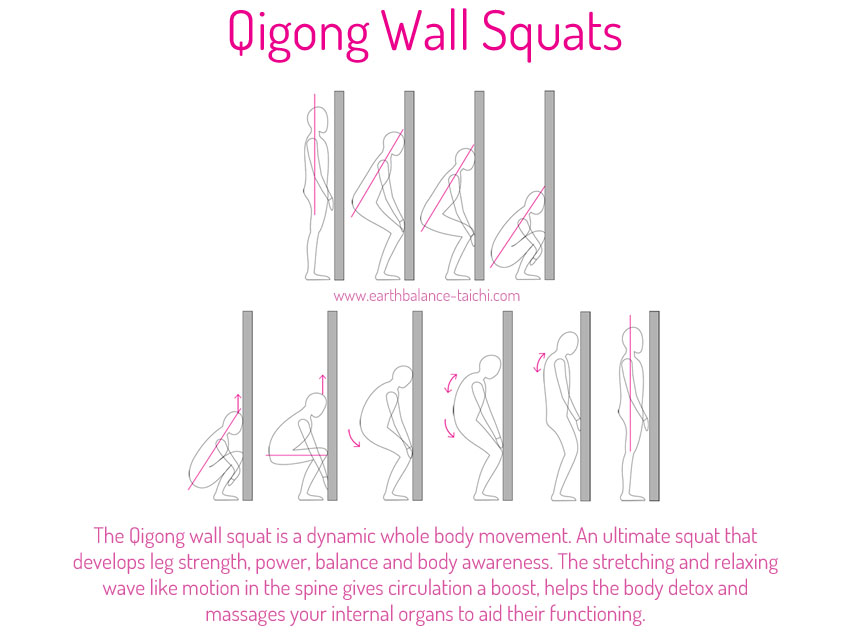
- No impact.
- Deep internal movement that massages the whole body.
- Increases circulation, blood flow and oxygen distribution to the limbs.
- Increases energy and reduces fatigue.
- Helps to strengthen the kidney and adrenal organs.
- Aids the hormone system.
- Expands and compresses the internal organs, giving them a massage that cleanses and detoxifies.
- Helps activate the lymph system pump to draw toxins out of the body.
- Aids the central nervous system spine fluid circulate.
- Flexion and extension of the spine helps back problems.
- Aids joint flexibility and nourishment of the joints.
- Helps to strengthen and loosen the internal psoas muscle.
- Develops the hip hinge movement found in weight lifting and kettlebell exercises.
- Can assist weight loss.
- Use as a way to reduce stress.
Traditional Chinese Medicine Benefits
- Stimulates, opens and clears blockages from the kidney meridian channels (vitality, reproductive system).
- Stimulates, opens and clears blockages from the ren and du meridian channels.
- Opens the ming-men acupuncture point (opposite navel).
- Draws qi into the lower dantian.
- Aids circulation of qi around the whole body.

It’s important to loosen the body before squatting, to arm the body up and stretch the connective tissue and unbind the fascia.
- Tai Chi kua squat, wuji stance, double weighted.
- Forwards bow stance hip flexor loosening exercise left and right.
- Isolated spine flexion and extension.
- Wuji stance, hands on thighs, squat down, straight spine.
- Wuji stance, hands on thighs, squat down, roll tail-bone under, wave up the spine to rise up.
Squat Diagnostic
If you cannot squat all the way down to the ground with your feet flat on the floor. There is a diagnostic you can do to check whether you have tight ankles and Achilles tendons versus tight hip flexors? Lay down on your back, bring your knees up to your chest. If your knees do not reach your chest it is your hip flexors that need stretching and loosening, and if your knees do come all the way up it is your ankles/Achilles that need stretching and loosening.
- The knees are hinges, they are a weight transferring joint and not a weight bearing joint.
- Protect the knees by ensuring the knees do not go passed the toes.
- Keep the weight behind the heels.
Toe Tip
- The optimum position is with your toes at the wall, this can be difficult to achieve.
- The alternative is to position the toes a few inches away from the wall.
Beginner Modifications Straight Spine
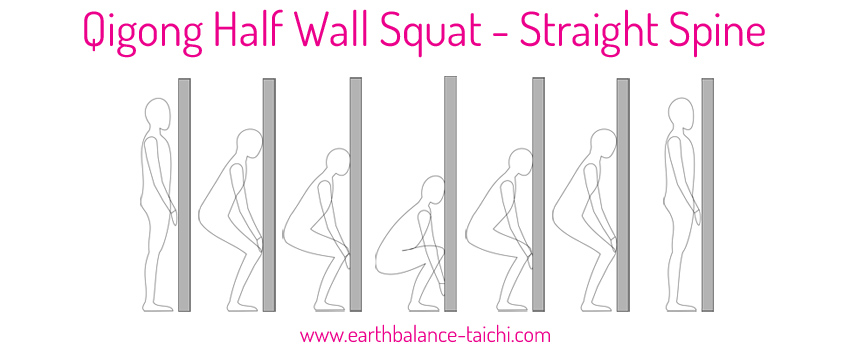
Half Wall Squat with Feet Hip Width
- Place your feet about hip width with the toes facing straight, with your legs either side of the door frame.
- You won’t be unable to press the knees together for stability, take care that the knees don’t wobble.
- Follow the body mechanics from the full wall squat "descending", except only squat down half way until the thighs are parallel with the ground.
- Keep the spine straight and rise to a standing position.
Half Wall Squat with Feet Together
- Place your feet together with the toes facing straight.
- Press the knees together for stability.
- Follow the body mechanics from the full wall squat "descending", except only squat down half way until the thighs are parallel with the ground.
- Keep the spine straight and rise to a standing position.
Beginner Modifications use a Door Frame
Half Wall Squat with a Door Frame with Feet Hip Width
- Place your feet about hip width with the toes facing straight, with your legs either side of the door frame.
- You won’t be unable to press the knees together for stability, take care that the knees don’t wobble.
- Hold onto the edge of the door frame with your fingers.
- As you descend down your arms will extend.
- Squat down half way.
- Pause to feel a lengthening and stretching sensation travelling down your mid to lower back.
- Roll the tail-bone / pelvis under to give momentum to rising upwards.
- Use the arms to assist the ascent by pulling the body upright.
- A wave-like motion goes through the spine as you rise.
- Rise to a standing position.
Full Wall Squat with a Door Frame
- Place your feet about hip width with the toes facing straight, with your legs either side of the door frame.
- Hold onto the edge of the door frame with your fingers.
- As you descend down your arms will straighten.
- You can move the hand position to assist the depth of your squat.
- Pause at the base of the squat to feel a lengthening and stretching sensation travelling down your mid to lower back.
- This will open your ming-men point (opposite navel on the lower back).
- Start to rise the body upwards, pulling up with the baihui (crown point) on the top of the head.
- Rise out of the squat until the thighs are parallel with the floor.
- Roll the tail-bone / pelvis under with a scooping motion, pulling the body up from the crown and the tail-bone curving.
- Use the arms to assist the ascent by pulling the body upright.
- A wave-like motion goes through the spine as you rise.
- Rise to a standing position.
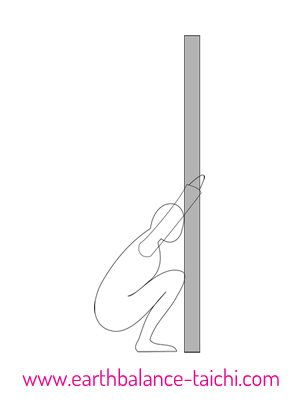
* You can also use column or railings, or something that you can hold onto with the arms to help your stability.
Beginner Modifications with Wave the Spine
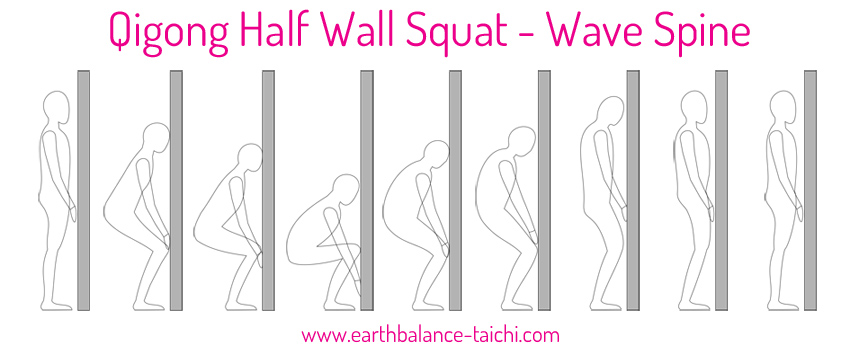
Half Wall Squat with Feet Hip Width
- Place your feet about hip width with the toes facing straight, with your legs either side of the door frame.
- You won’t be unable to press the knees together for stability, take care that the knees don’t wobble.
- Follow the same process as for the full wall squat.
- Except, only squat down half way until the thighs are parallel with the ground.
- Pause to feel a lengthening and stretching sensation travelling down your mid to lower back.
- Roll the tail-bone / pelvis under to give momentum to rising upwards.
- A wave-like motion goes through the spine as you rise.
- Rise to a standing position.
Half Wall Squat with Feet Together
- Place your feet together with the toes facing straight.
- Press the knees together for stability.
- Follow the same process as for the full wall squat.
- Squat down half way.
- Pause to feel a lengthening and stretching sensation travelling down your mid to lower back.
- Roll the tail-bone / pelvis under to give momentum to rising upwards.
- A wave-like motion goes through the spine as you rise.
- Rise to a standing position.
Full Wall Squat in Detail

| PROCESS | Body Mechanics Descending |
| Toes | A few inches away from the wall. |
| Feet | Together. |
| Ankles | Use the ankles as a hinge to bring your upper body forwards to lean into the wall. |
| Knees | The knees do not go passed the toes when squatting. |
| Core | Brace the spine by activating the lower abdominal muscles, drawing these muscles in towards the lower back. This helps keep the spine straight when squatting and protects the lower back. This is also called drawing dantian (navel point) towards ming-men (opposite navel point) in Traditional Chinese Medicine. |
| Tail-bone | By drawing dantian towards ming-men, this lengthens the tail-bone during the descent. |
| Spine | Keep the spine upright and straight as you squat. Avoid collapsing the upper body as you squat down. |
| Nose / Forehead | The nose or the forehead is close to or touches the wall. This assists your balance as you squat. |
| Chin | Withdraw the chin inwards towards the back of the neck gently. |
| Arms | The arms can be held out at an angle from the body for stability, or hold them loosely in front of the body. |
| Hands | The palms can face the wall. You can trace the fingertips down the wall as you squat. |
| Weight | Keep the weight back to help your body weight transfer behind the knees to the ground, not over your knees which puts weight onto the knees and is not advised. |
| At the Base | Pause to feel a lengthening and stretching sensation travelling down your mid to lower back. You can extend the tail-bone more as you pause. |
| Arms at the Base | You can relax the arms down during the pause stage, or hold the legs for stability. |
| Lower Back at the Base | At the base of the squat the lower back and sacrum naturally round as the tail-bone drops down. |
| Focus | On the descent the focus is on the lower dantian. |
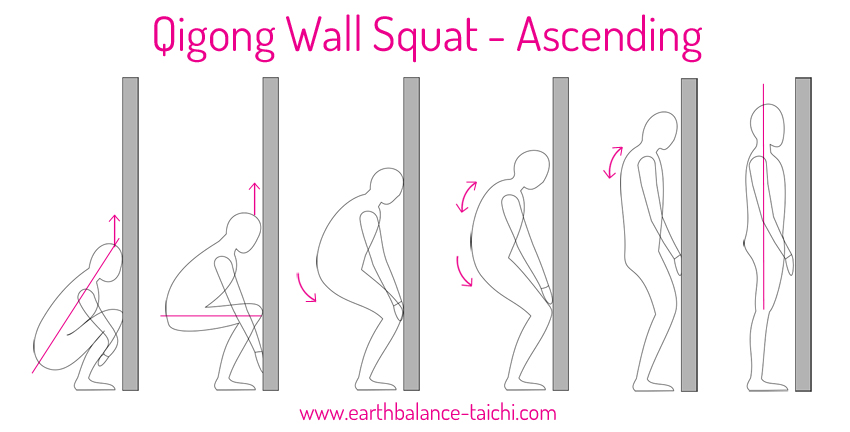
| PROCESS | Body Mechanics Ascending |
| Lower Back | Start from a position where the lower back and sacrum have rounded under naturally. |
| Feet | Do not push the feet into the ground to give momentum to rising up. |
| Legs | Do not push with the leg muscles to give momentum to rising up. |
| Ankles | Continue to use the ankles as a hinge to bring your upper body forwards to lean into the wall as you rise. |
| Crown | Start to rise the body upwards, pulling up with the baihui (crown point) on the top of the head. |
| Tail-bone / Pelvis | Rise out of the squat until the thighs are parallel with the floor. Then roll the tail-bone / pelvis under with a scooping motion, pulling the body up from the crown and the tail-bone curving. |
| Shoulders | By rolling the tail-bone / pelvis under this enables your shoulders to stay relaxed and not rise up by your ears as you rise. |
| Spine | The scooping motion creates a wave-like motion, with the spine curving as you rise. It can also be described as a snake or caterpillar like motion. |
| Chin | Continue to withdraw the chin inwards towards the back of the neck gently. |
| Nose/Forehead | The nose or the forehead is close to or touches the wall. This assists your balance as you rise. |
| Arms | The arms can be held out at an angle from the body for stability, or hold them loosely in front of the body. |
| Hands | The palms can face the wall. You can trace the fingertips up the wall as you rise. |
| At the Top | Return to a relaxed standing position, before repeating the process. |
| Focus | On the ascent the focus is on raising up from the baihui (crown) and waving the motion up through the spine. |
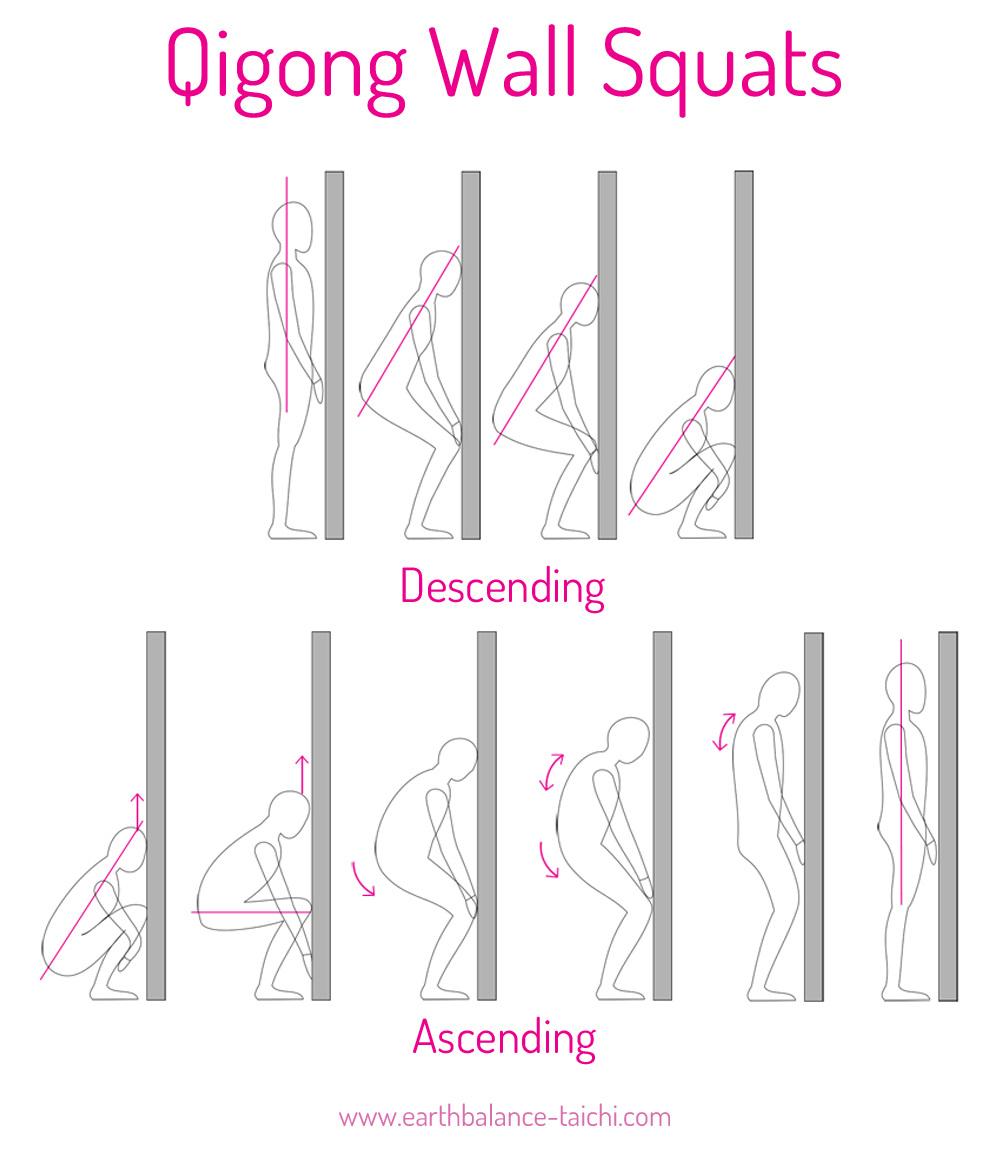
* Please note that the Taoist practices are not a replacement for conventional medical treatment. Please speak with your doctor prior to starting a new exercise programme. This article is for information purposes only and must not be taken as medical advice. *
